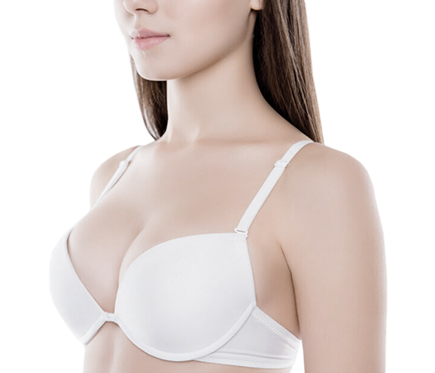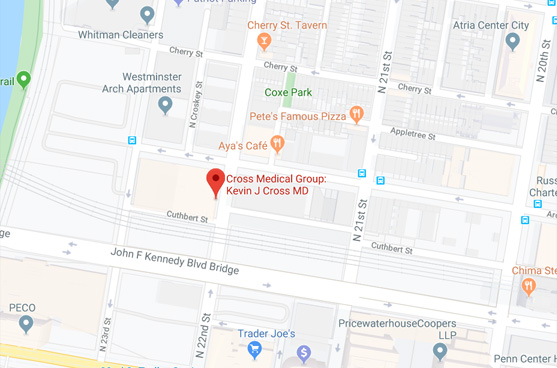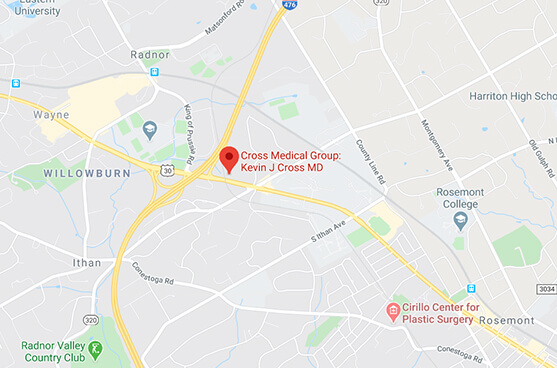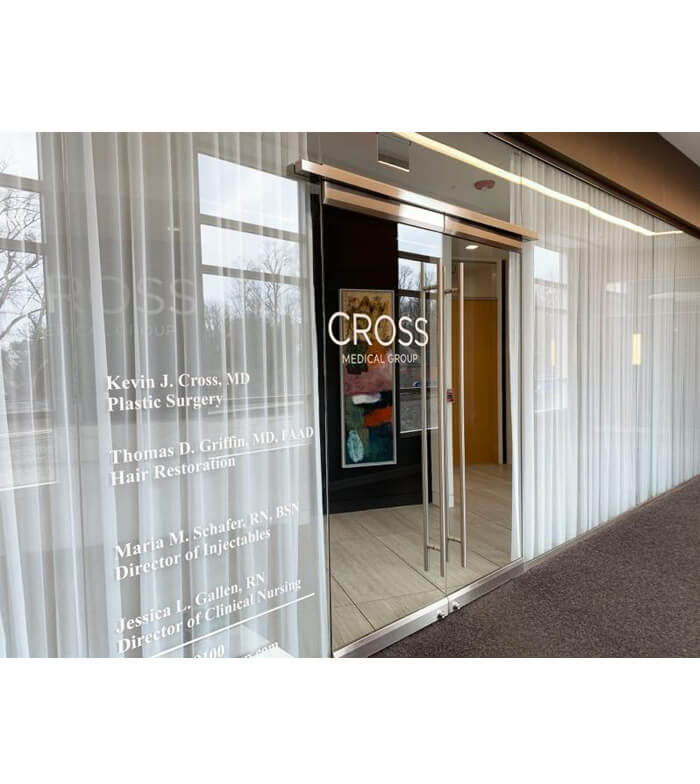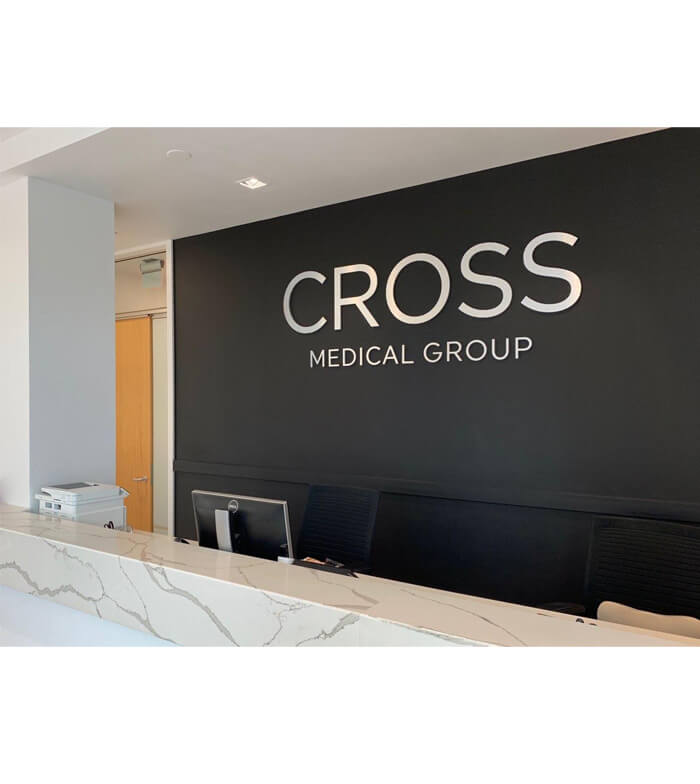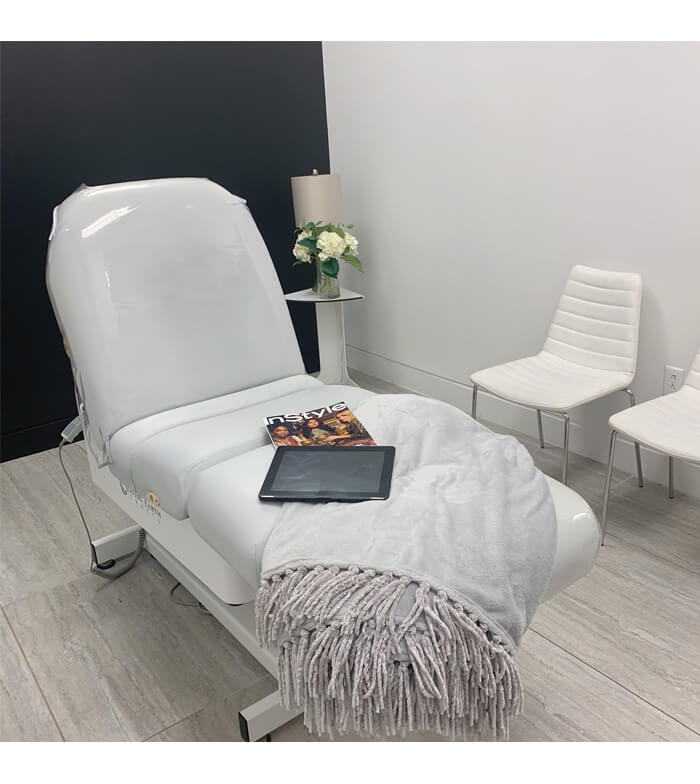Breast Augmentation
Add Volume With Breast Implants, Fat Transfer, or Both in the Philadelphia, PA, Area
Breast augmentation at the Philadelphia area's Cross Plastic Surgery is a surgical procedure that can benefit a wide range of patients. Breast implants can effectively help young women feel more proportional, can help someone who has seen changes occur to her breasts after having children, or can be used when weight loss, age, or menopause have caused one or both breasts to "deflate."
For years, breast augmentation surgery was limited to changes that could be made with the use of breast implants. Today, Dr. Kevin Cross can use breast implants, fat transfer (taking fat from other parts of the body and putting it in the breasts), or a combination of the two to help you achieve your ideal goals and results.
SCHEDULE A CONSULTATION
Schedule a breast augmentation consultation today by calling Cross Plastic Surgery at (215) 561-9100 (Philadelphia) or (610) 688-9100 (Villanova), or send a message online.
What Are Breast Augmentation Procedure Details?
Breast augmentation is typically performed in an outpatient setting. The procedure itself takes between one and two hours. Dr. Kevin Cross's team uses a newly developed protocol that decreases the chance of nausea following the procedure, as well as allows for a more rapid recovery from anesthesia. You can usually return to work after a few days and may resume your full exercise routine and typical daily activities after two weeks.
If breast implants are being used, Dr. Cross will make small incisions, often not much longer than the width of two fingers. He will position the devices accordingly, either above or below your chest muscle— depending on your desires and anatomy—then close the incisions. If fat grafting is part of the breast augmentation procedure, he will carefully remove fat cells from elsewhere on your body—such as the thighs or buttocks—then process them before injecting them to add volume while creating a natural shape and look. It is important that the fat cells are handled with care, as they need to remain alive so that they connect back into your body's systems when injected for breast augmentation.
Women generally experience minimal to moderate pain after breast augmentation surgery. When the breast implant is placed under the chest muscles, your chest itself will feel tight for a few days while the body adjusts to the presence of the devices.
What Are the Breast Implant Options?

Breast implants come in a variety of shapes and sizes. Smooth, round, silicone-filled implants are the most common type used for breast augmentation throughout the United States, but Dr. Cross also uses saline implants in a large number of his patients, depending on individual wishes and anatomy
There was a period from the 1990s to mid-2000s when the FDA banned silicone-filled breast implants over a concern that the filler material was causing strange autoimmune-like symptoms in women who chose them for breast augmentation. During that time, only saline-filled implants were available for routine breast augmentation. Studies on thousands of women who had silicon-filled implants, saline-filled implants, and no breast implants at all found that there was not an association between the implants and these symptoms. Silicone implants returned to the market in 2006.
Dr. Kevin Cross aims to maximize patient satisfaction, so he makes choosing the right size and dimension of breast implant a meticulous process at his office. A long discussion during your initial consultation helps him to understand the general aesthetic desires you bring to the procedure. From there, he will conduct an exam that involves taking measurements, as well as scans for the Vectra Imaging System. This system creates realistic, three-dimensional images that allow you to see what your body could actually look like. A range of simulated implants lets you "try on" different sizes so you can more easily envision your ideal look.
Finally, Dr. Cross presents breast augmentation before and after photos, choosing images of patients that are similar to you in terms of body type and cosmetic goals. In reviewing these before-and-after photos, you can see real-world examples of what the results of your surgery can look like.
MEET DR. KEVIN J. CROSS
Dr. Cross is a board-certified plastic surgeon. His philosophy is to develop an individualized treatment plan for each of his patients while using his breadth of experience to ensure that his patients receive long-lasting, natural appearing results that reach their aesthetic goals.
Implant Placement for Breast Augmentation
For breast augmentation with implants, Dr. Cross will position the implant either under a patient's natural breast tissue (subglandular placement) or under the pectoralis major muscle, the predominant muscle of the chest (submuscular placement). Both options have unique advantages, and Dr. Kevin Cross will work with each individual patient to determine which is ideal for her specific case.
Putting the implant above the muscle allows for the implant to help define more of the breast shape. This is important in breast augmentation patients with poor natural shape to their breasts. It also prevents movement of the chest muscles from affecting the movement of the implants.
Putting a breast implant under the pectoralis muscle helps camouflage the device in patients with very little of their own breast tissue, and makes future testing for breast cancer easier in high-risk patients.
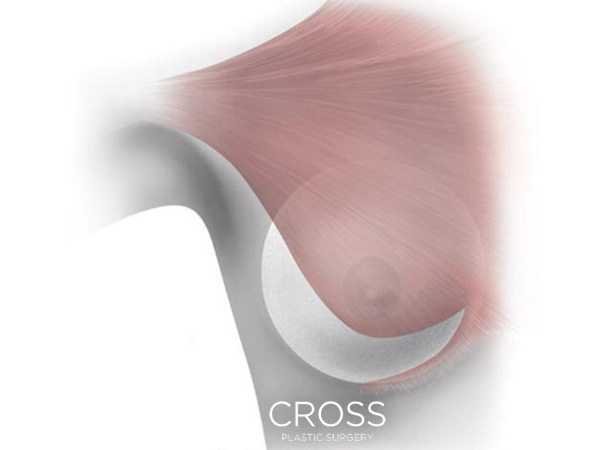
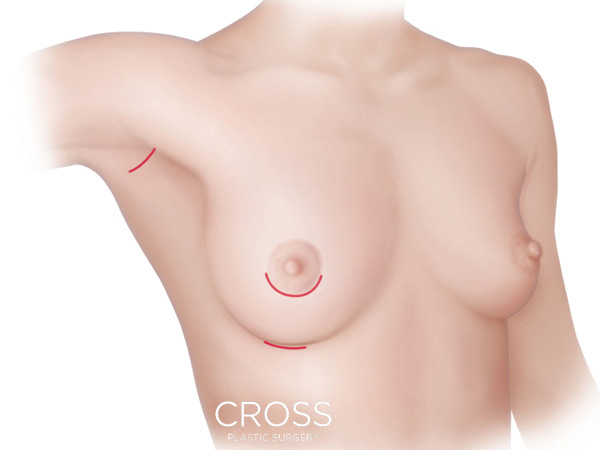
To insert the implants for breast augmentation, small incisions can be hidden in the lower fold of the breast, around the junction where the darker pigment of the areola meets the lighter skin of the breast, or through an incision placed in the armpit.
While each of these incisions has advantages for certain patients, placing the incision in the under-fold of the breast is the approach with the highest likelihood of producing the most stable and precise result. If a breast lift is being performed at the same time as the breast augmentation, the incision that is made for the lift can also be used to insert the implant.
What Is Post-Childbirth Breast Augmentation?
Dr. Kevin Cross treats post-childbirth breast augmentation as its own separate procedure, since pregnancy and breastfeeding alter the breasts in ways that require specific surgical solutions.
Restoring shape and balance to a woman's breast with post-childbirth breast augmentation presents a unique set of challenges. The rapid increase in breast size during lactation acutely stretches the ligaments of the breast in a way that prevents the breast from ever returning to its pre-pregnancy shape. Additionally, breasts often lose—or, less often, gain—volume after having children and breastfeeding.
Though a lift, augmentation, or reduction alone will at times be all that is required to restore proper shape to the breast, restoration often requires a combination of lifting of the breast and adding volume through a breast implant or the use of one's own fat, or reducing breast volume while performing a lift for shaping purposes. Deciding what combination of these options is going to provide the best long-term outcome for a patient is an important part of the consultation and planning process that takes place at the Philadelphia area's Cross Plastic Surgery.

*Results May Vary
Before & After Photo Gallery
See for yourself the patient transformations that can be achieved by Dr. Cross and his team.
Life After Breast Augmentation
Mammography of the breast is affected by the presence of an implant, and it is known that a portion of the breast is harder to visualize with a mammogram. For this reason, women with implants require specialized mammographic images called Eklund views. That said, know that when thousands of women with and without implants were compared, there was no significant difference between the two groups regarding rates of breast cancer diagnosis, time at which the cancer was diagnosed, or risk of mortality from breast cancer.
Similarly, a study into concern for breastfeeding after breast augmentation with implants revealed that while breast milk in patients with implants may contain trace amount of silicone, it is significantly less than the levels of silicone found in infant formula and bottled milk. While breast augmentation may affect the ability to produce milk in some women, it appears that women who want to breastfeed are able to do so— though small studies show that some may require supplementation, just like women without breast implants who attempt to breastfeed.
Ultimately, breast augmentation is an ideal way to create or restore balance and shape to an area you cannot change on your own, allowing you to feel more comfortable with your proportion and appearance.
What Are My Surgery Options Beyond Breast Augmentation?
Breast augmentation is just one type of breast surgery available at Cross Aesthetics. In addition to breast enlargement, Dr. Kevin Cross also offers breast reductions for women looking to reduce volume, as well as gynecomastia surgery for men who want to address the unwanted development of breast tissue.
Breast augmentation may also be part of a more inclusive Mommy Makeover, designed to create proportions, shapes, and curves more in line with a woman's pre-pregnancy body. This suite of services may include liposuction, a tummy tuck, and other surgical procedures and nonsurgical treatments.
SCHEDULE A CONSULTATION
Contact Cross Aesthetics for breast augmentation in Philadelphia (215) 561-9100 or Main Line's Villanova (610) 688-9100. You can also send a message online to inquire about a consultation, or for more information.



